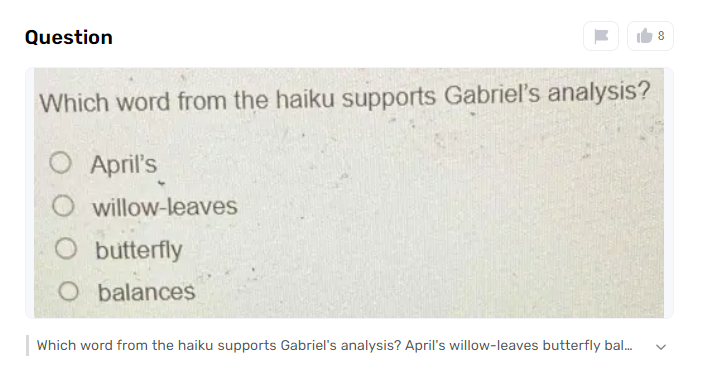Dennis is a hard-working business professional who enjoys spending time with his family and friends. He likes to stay active, and loves playing sports. Stephanie is always looking for new challenges and opportunities to grow both personally and professionally.

Haiku, a loved work of art established in old Japan, rises above its curtness to catch short-lived minutes and bring out significant feelings. In contrast to lengthy narratives, haiku relies on concise imagery, with each word carefully selected to convey a vivid image within the strict 5-7-5 syllable structure of the poem.
Analyzing haiku can be like solving a beautiful riddle, it can be a very satisfying activity. However, it frequently requires us to become detectives, carefully analyzing the meaning of each word and its intricate connection to the others. Which word from the haiku supports gabriel’s analysis? april’s willow-leaves butterfly balances and how the word can serve as a master key to unlock a deeper understanding of a particular haiku is the topic of this fascinating article.
Identifying the Chosen Word and Its Significance
Having laid out the groundbreaking power a solitary word can hold inside a haiku, we should now furnish ourselves with the instruments to open its privileged insights. Using Gabriel’s chosen word, we go through a step-by-step procedure to analyze the haiku, turning it from a seemingly straightforward poem into a source of deeper meaning.
Embrace the Haiku
The initial step is to drench yourself completely in the actual haiku. Peruse it so anyone might hear, appreciating the beat and the heaviness of every syllable. Give close consideration to how the words collaborate with one another, making an embroidery of symbolism and feeling.
Finding Gabriel’s Purpose
Then, we should distinguish the particular word that aroused Gabriel’s curiosity. With a phrase like “Let’s take a closer look at the word ‘balances’ in the second line,'” this could be explicitly mentioned in the discussion context. On the other hand, pieces of information may be installed inside the discussion, where Gabriel underlines a specific word by waiting on it or utilizing spellbinding language to feature its importance.
Examining the Role of the Word
Whenever you’ve recognized Gabriel’s picked word, now is the ideal time to dive into its inward operations and comprehend how it capabilities inside the haiku. Here, we take on the role of detectives and examine the word from various perspectives:
Grammatical Feature
Is it a thing, the establishment whereupon the haiku rests? Is it a verb that gives the scene life and action? Or on the other hand, maybe it’s a descriptive word, adding a smidgen of variety or surface to the sonnet’s material. The grammatical function of the word helps us comprehend its contribution to the overall structure.
Sensory Details
Does the word bring to mind a particular sensation? Does it lay out an image for our eyes, a song for our ears, or a scent for our nose? It could be that it brings to mind the sensation of touch, the freshness of a spring breeze, or the delicate flutter of butterfly wings.
Profound Association
Does the picked word ignite a close-to-home reaction? Does it bring out a feeling of harmony, satisfaction, despair, or maybe even a touch of risk? Take into consideration how this word affects the overall mood set by the haiku.
Meshing the Word Back into the Poem
We now return to the entirety of the haiku after carefully analyzing the chosen word. Perceive what this single word cooperates with and means for different components of the sonnet:
Occasional Setting
Does the picked word support the kigo, the occasional reference that frequently grounds a haiku in a particular season? Maybe “April” lays the right foundation for spring, a time of reestablishment, and “balances” stresses the dubious idea of this new life.
Imagery
How does the picked word add to the general picture introduced in the haiku? Does it stand out as the main focus, or does it blend in seamlessly, enhancing the imagery that is already there? Take into consideration how balances might emphasize the butterfly’s vulnerability while it is perched on a breeze.
Emotional Resonance
Does the word chosen enhance the haiku’s emotional impact or add a new layer of feeling? By zeroing in on balances, the peruser could now encounter a feeling of strain and worry for the butterfly’s prosperity, adding profundity to the sonnet’s personal centre.
Steps to Use Gauth
While utilizing Gauth, the simulated intelligence schoolwork partner application, the means are streamlined to these three central activities:

Step 1: Input Question
You can use the app’s camera to take a picture of the problem (equation, graph, etc.) or type a clear question into the app.
Step 2: Sit Tight for Handling
Whenever you’ve input your inquiry, Gauth finds an opportunity to break down it. This handling time can shift contingent upon the intricacy of the inquiry, yet all at once it’s generally very quick.
Step 3: Get Results
In the wake of handling, Gauth will give you the arrangement. This commonly includes a bit-by-bit clarification that guides you through the method involved with taking care of the issue.
Summary
By focusing on a solitary word picked by Gabriel, we can open secret profundities inside a haiku. The poem’s imagery and overall impact are shaped by its emotional connection, figurative language, and part of speech. We are able to appreciate the haiku not only for its surface beauty but also for the many layers of meaning it contains thanks to this in-depth examination.
